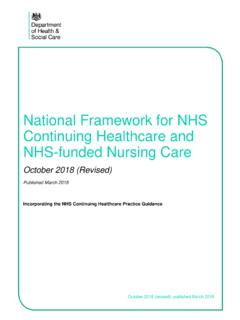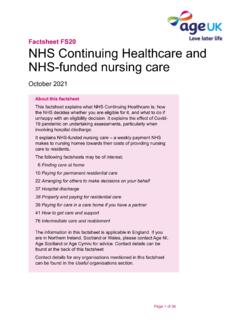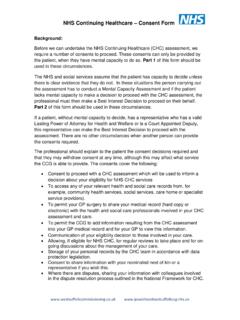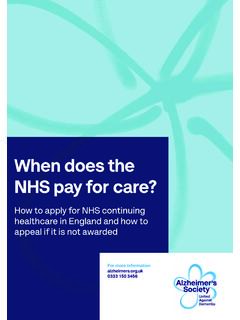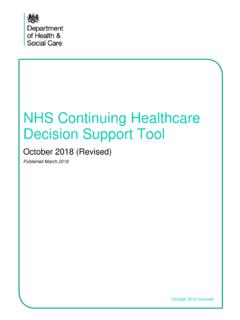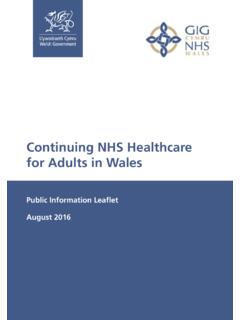Transcription of Fair Shares - a guide to NHS allocations - NHS England
1 Fair Sharesa guide to NHS allocationsInfographics (updated and expandedfor CCG allocations 2019/20 onwards)NHS England and NHS ImprovementOverview of NHS funding Approaches to allocationsLatest updatesPopulationsUpdates to new formulaEvaluationMap keyConverting target Shares into cashVocabularyNeed weightsAdviceMathematicsGlossary of terms used in NHS allocations25 Issues with GP populations27 Projecting GP populations for future years26 Update to population baselines and projections28 Hospital data quality directly affects CCG allocation29 Taking better account of health inequalities30 Community services formula31 Mental health Formula Refresh32 Market Forces Factor (MFF)33 Understanding the formula34 Constructing the formula35 Showing the effect of updating the model36 Comparison with other CCGs37 Waterfall chart age vs deprivation38 Limitations of model, areas for further work39 Independent advice and support40 Find my CCG41 Further reading42 Changelog43 Contact us44 Annex3 Introduction4 Contact details 5 How much do we spend on patient healthcare?
2 6 Where does the money go?7 What are CCGs?8 Fair Shares ?9 Portion control making it more fair10 Using cartograms for clearer data visualisation11 What evidence is used to show variation in need?12 Examples of need variation in England13 Components of target allocations 14 How a CCG s share is adjusted15 Combine adjustments to get target share16 Summary of adjustments included17 From target Shares to final allocations18 Pace of change policy core ideas19 Pace of change calculation20 Examples of targets and final allocations21 Moving targets22 Key steps in the allocations process23 Changes to 2019/20 allocationsFair Shares - a guide to NHS allocationsTable of Contents2 NHS England and NHS Improvementare currently merging, but this is beyond the scope of this document.
3 As CCG allocations are an NHS England commissioning function, this name persists in these England leads the national health Service (NHS) in England . We set the priorities and direction of the NHS and encourage and inform the national debate to improve health and care. We want everyone to have greater control of their health and their wellbeing, and to be supported to live longer, healthier lives by high quality health and care services that are compassionate, inclusive and constantly England Shares out more than 100 billion in funds and holds organisations to account for spending this money effectively for patients and efficiently for the taxpayer. A lot of the work we do involves the commissioning of health care services in England .
4 We commission the contracts for GPs, pharmacists, and dentists and we support local health services that are led by groups of GPs called Clinical Commissioning Groups (CCGs). CCGs plan and pay for local services such as hospitals and ambulance services . We strongly believe in health and high quality care for all, now and for future use a statistical formula to make distribution of financial resources fair and objective, so that it more clearly reflects local healthcare needs and hopefully reduces any health updated and expanded summary of our allocations Technical Documentationdetails the recent updates in the 2019/20 allocations model. We have used infographics and metaphors to help make some complex ideas easier to digest.
5 We hope you find these slides useful in explaining some of the methods used. The annex includes more complex slides, where we describe some of the ideas in a bit more detail. Overview of NHS allocations Introduction3A visual document, developed in presentation software, intended to be read on screen and referenced instead of Duarteslidedoc (n.)Infographics (updated and expanded for CCG allocations 2019/20 onwards)Document TitleFairShares a guide to NHS allocationsWritten and illustrated by Roman Tatarek-Gintowt, Analysis and Insight for FinanceWith thanks to colleagues in NHS England and NHS Improvement Correspondence addressAllocations Team, Quarry House 8E25, Quarry Hill, Leeds LS2 7 UEWeb where latest version is publishedWe are continually developing both the allocations process and related documentation.
6 We welcome your comments and feedback to help us improve them. allocations Infographics)Document published by NHS England and NHS Improvement Date 10 February 2020 Latest Publications Approval Reference 001520 PrintingThese slides are designed for viewing on screen, rather than printed. Pleaseconsider if you really need to print them out. We suggest printing 2 slides per A4 sheet, double sided = total11 details4 NHS England and NHS ImprovementSource: Office for Budget Responsibility (OBR) UK Government Revenue & Spending Forecast 2019/20 (figures rounded)The NHS in England has a budget of 130 billion. Total UK health spending is 151 billion, around 18% of the budget (7% of GDP)deficitdebtOverall debt 1,878 bn (82% of GDP)Debt Interest 2018/19 40 bnBorrowing 2019/20 29 bnDevolved parliaments in Scotland, Wales and Northern Ireland receive a public services budget (including health ), to spend according to local priorities billionsSpending 130 health ( England ) 64 Education28 Defence90 Other public services101 State pensions101 Other welfare47 Investment40 Debt interest25 Tax credits (personal)214 Other spending 841 bnTaxesBorrowing (deficit)
7 29 Income tax339 VAT137 Corporation Tax58 Council Tax 36 Business Rates31 Fuel Duty28 Capital Taxes31 Other Taxes96 Other receipts55 841 bnThe chancellor s job is to balance a public spending plan against money raised in taxes plus borrowing (deficit), reflecting government values & budget How much do we spend on patient healthcare?5 61%CCGsClinicalCommissioningGroupsRunnin gcostscap1%Public HealthGrants LAs152 Local CommissioningSimplified funding flows % of total NHS budget (calculated from expenditure in 2016/17 or earlier) are indicative to give a sense of scale and may not reconcile back to accounts (numbers rounded)Due to the nature of funding flows some Local Authority/ Better Care Fund (BCF) expenditure may be double counted in other areas of CCG expenditure.
8 Mental health reported figures vary depending on the definition used, total spending on MH across all settings was estimated to be ( ) in 2015/16. Public health grants are under review as part of local government financial reform. PH spending may be higher under OECD definition (could also include dental services / GP disease prevention smoking, obesity)We hope to update this slide soon, early indications are that percentages have remained fairly Support Activityincluding Data Collection / IT services Quality Monitoring and RegulationSupport and ImprovementEducation and Workforce Training Business services , LitigationHealth improvement and evidence based interventions to tackle substance misuse, smoking & tobacco, children s health , sexual health , obesity, physical activity, and preventing infectious disease.
9 Also pandemic flu vaccines ( ).Public health Grants to LAs distributed by 7a budgets direct from DH to NHS Care including care homes, drop-in centres, voluntarysector Public HealthTotal CCG place-based allocationsHealthcare ServicesGeneral PracticePrimary care GP surgeries, GPs and practice teams 6%Acute CareAccident and Emergency (A&E), maternity, outpatient, acute hospital care, elective/ day case, non-elective, ambulances 33%Mental HealthTreatment in dedicated facilities and other care settings, Improving Access to Psychological Therapies (IAPT) ServicesCare for some uncommon conditions, for which there are few providers or costs are very high. CommissionedPublic health (screening programmes, child 1% health info, immunisation, sexual assault) prison healthcare, armed forces families,some specialised services 5%Community HealthCommunity nursing/ other support 6%Continuing Healthcare 4%Cost of medicines prescribed by GPs for their patients 7%Other Primary CareCommunity pharmacy, dental services , ophthalmic (eye tests, glasses) 4%Better Care Fund (BCF) - programme to join up health and social care services 3%Central funding + council taxWhere does the money go?
10 687%100% Programmes211 CCGs (2013)209 CCGs (2015) 207 CCGs (2017)195 CCGs (2018)191 CCGs (2019)*NHS EnglandDirect commissioningCo-commissioningPurchasersR esident and GP populations are different due to a variety of factors, including cross-border flows, temporary migration and list slide Issues with GP million patients (2019) registered with a GP practice in England (NHS Digital) million people (2018)estimated in England (ONS)Patients*The allocations model described was based on 192 CCGs, as the CCG merger in Devon had not been confirmed in time to include it. Source - NHS Confederation: Key statistics on the NHS135 acute non-specialist trusts (84 foundation)17 acute specialist trusts (16 foundation)56 mental health trusts (42 foundation)7,454 GP practices35 community providers - 11 NHS trusts, 6 foundation trusts and 17 social enterprisesand 1 limited company853 for-profit and not-for-profit independent sector organisations, providing care to NHS patients from 7,331 locationsProvidersGPsnursespublichospita l doctorsmanagersLed by GPs and nurses, Clinical Commissioning Groups (CCGs)










